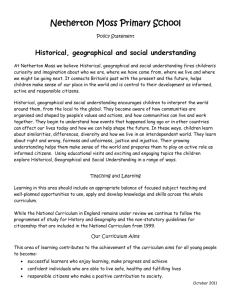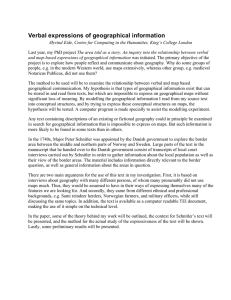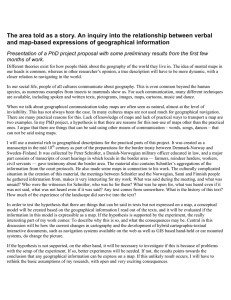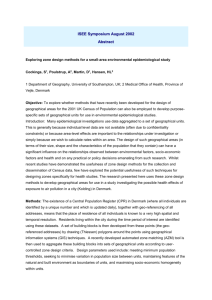DESIGN OF GEOGRAPHICAL INFERENCE ENGINE
advertisement
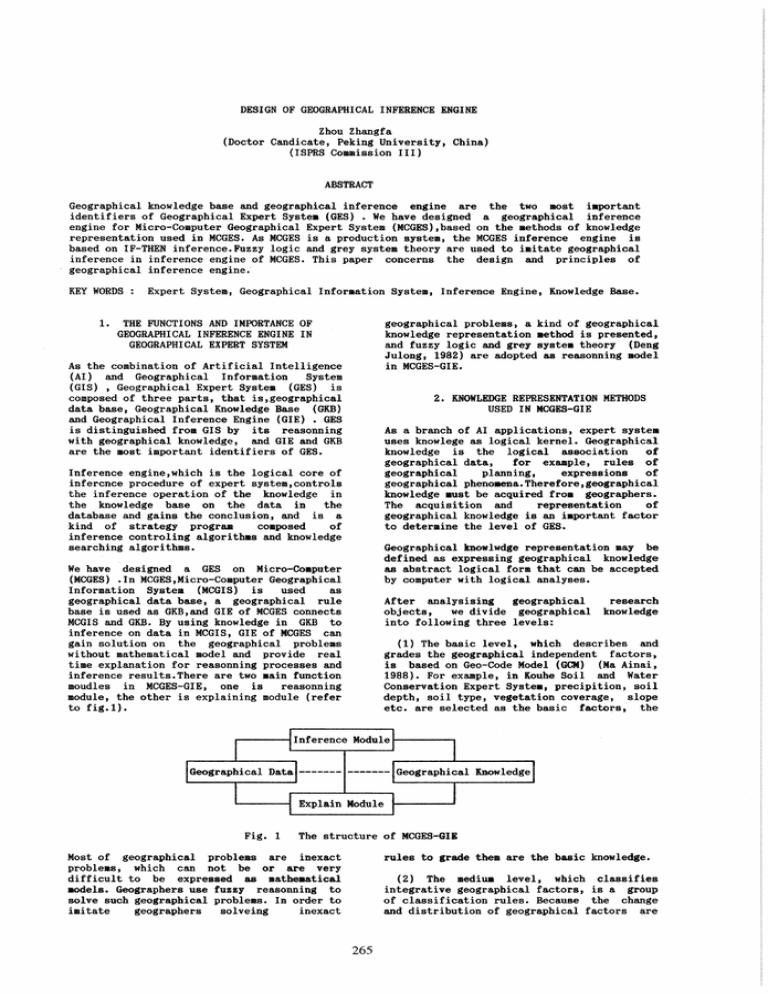
DESIGN OF GEOGRAPHICAL INFERENCE ENGINE
Zhou Zhangfa
(Doctor Candicate, Peking University, China)
(ISPRS Commission III)
ABSTRACT
Geographical knowledge base and geographical inference engine are the two most important
identifiers of Geographical Expert Systell (GES) • We have designed a geographical inference
engine for Micro-Computer Geographical Expert System (MCGES),based on the methods of knowledge
representation used in MCGES. As MCGES is a production system, the MCGES inference engine is
based on IF-THEN inference. Fuzzy logic and grey system theory are used to imitate geographical
inference in inference engine of MCGES. This paper concerns the design and principles of
geographical inference engine.
KEY WORDS:
1.
Expert System, Geographical Information System, Inference Engine, Knowledge Base.
THE FUNCTIONS AND IMPORTANCE OF
GEOGRAPHICAL INFERENCE ENGINE IN
GEOGRAPHICAL EXPERT SYSTEM
geographical problems, a kind of geographical
knowledge representation lIethod is presented,
and fuzzy logic and grey system theory (Deng
Julong, 1982) are adopted as reasonning model
in MCGES-GIE.
As the combination of Artificial Intelligence
(AI) and Geographical Information System
(GIS) , Geographical Expert System (GES) is
composed of three parts, that is,geographical
data base, Geographical Knowledge Base (GKB)
and Geographical Inference Engine (GIE) • GES
is distinguished from GIS by its reasonning
with geographical knowledge, and GIE and GKB
are the most important identifiers of GES.
2. KNOWLEDGE REPRESENTATION METHODS
USED IN MCGES-GIE
As a branch of AI applications, expert system
uses know lege as logical kernel. Geographical
knowledge is the logical association of
geographical data,
for example, rules of
geographical
planning,
expressions of
geographical phenoaena.Therefore,geographical
knowledge BUst be acquired froll geographers.
The acquisition and
representation
of
geographical knowledge is an important factor
to determine the level of GES.
Inference engine,which is the logical core of
inference procedure of expert system,controls
the inference operation of the knowledge in
the knowledge base on the data in
the
database and gains the conclusion, and is a
kind of strategy program
composed
of
inference controling algorithms and knowledge
searching algorithms.
Geographical knowlwdge representation may be
defined as expressing geographical knowledge
as abstract logical form that can be accepted
by computer with logical analyses.
We have designed a GES on Micro-Computer
(MCGES) .In MCGES,Micro-Computer Geographical
Information System (MCGIS) is
used
as
geographical data base, a geographical rule
base is used as GKB,and GIE of MCGES connects
MCGIS and GKB. By using knowledge in GKB to
inference on data in MCGIS, GIE of MCGES can
gain solution on the geographical problems
without mathematical model and provide real
time explanation for reasonning processes and
inference results. There are two lIain function
moudles in MCGES-GIE, one is
reasonning
module, the other is explaining module (refer
to fig.1).
After analysising
geographical
objects,
we divide geographical
into following three levels:
research
knowledge
(1) The basic level, which describes and
grades the geographical independent factors,
is based on Geo-Code Model (GCM) (Ma Ainai,
1988). For example, in Kouhe Soil and Water
Conservation Expert Systell, precipition, soil
depth, soil type, vegetation coverage, slope
etc. are selected as the basic factors, the
r-------~Inference Module~------~
Explain Module
Fig. 1
The structure of MCGES-GII
Most of geographical problems are inexact
problells, which can not be or are very
difficult to be expressed as lIatheaatical
models. Geographers use fuzzy reasonning to
solve such geographical problems. In order to
imitate
geographers
solveing
inexact
rules to grade them are the basic knowledge.
(2) The mediUII level, which classifies
integrative geographical factors, is a group
of classification rules. Because the change
and distribution of geographical factors are
265
successive, the medium rules always use fuzzy
methods to classify them. Here is a sample
example, from grassland to forest,
tree
gradualy substitute grass, we can not find a
absolute boundary to delimite grass
and
forset, so in order to classify them, fuzzy
mathematics are used
to
build
fuzzy
classification model.
The effectiveness of rules points out the
corelation between evidence and conclusion.
P{C), P (EtC) and P(E:~C) are used to express
conclusion prior
probability,
evidence
probabili ty if the conclusion exists and
evidence probability if the conclusion does
not exist.
Examples of rule are shown as following,
(3) The advanced level is a series of
integrative geographical planning
rules,
always is a set of experience of geographer.
MCGES expresses geographical knowledge
the form of production-rule.
The
defination of MCGES
knowledge
is
following:
'rule-17:
with
BNF
as
'if: slope == 3,
1*
(1) The basic level
<factor>::=<factor naae><factor grading>
I
1
I
2
'then:
'effect: 0.22,
I ...
0.40,0.45,
1* slope: peE : C), peE
<rule>::=IF <evidence> THEN <conclusion>
<effectiveness>
"'C)
C), p(E
C), peE
"'C)
*1
C) ,peE
"'C)
*1
1. 00, 0.85;
1* landuse : peE : C), peE :
I
'rule-81:
<geographical type>::=geographical typel I
geographical type2 I ...
<geographical value>::=geographical valuel I
geographical value2 I ...
1* from MCGES for Kouhe Soil&Water
Conservation Expert System *1
'then:
tree planting;
1* planting tree to conserve S&W *1
I •••
'effect: 0.18,
1* tree planting prior probability *1
0.15,0.35,
1* slope: P(ElC),
Here is an example of MCGES basic knowledge,
1* from MCGES for Kouhe Soil&Water
Conservation Expert System *1
slope
grade
grade
grade
grade
grade
grade
*1
'if: slope == 3,
soil_depth == 3,
erosion_type == water_erosion,
erosion_density -- 2,
landuse == 8;
1* uncultivated land *1
<final conclusion>::=<geographical process>
1*
1*
1*
1*
1*
1*
1*
~C)
'relative: rule-29,rule-36,rule-81,
rule-90,rule-103j
1* rules connected with #rule-17 *1
<temporary conclusion>::=<geographical type>
<geographical value>
<geographical process>::=
geographical processl
geographical process2
*1
0.21,0.74,
1* erosion_density:P(E
condition> AND
condition>
<conclusion>::=<temporary conclusion>
<final conclusion>
'name: slope;
1:
0,2
2,5
2:
5,8
3:
4:
8,15 ;
5:
15,25;
6:
25,- ;
"'C)
0.43,0.67,
1* erosion_type : peE
<condition>::=<factor name><factor grade>
'factor-l:
*/
0.65,0.70,
1* soil_depth : P(E
<effectiveness>::=
<conclusion prior probability>
{<evidence probability
if conclusion exist>
<evidence probability
if conclusion not exist>}
I
terrace;
/* terrace prior probability *1
(2) The medium and advanced level
<evidence>::=<condition
<condition
soil_depth == 3,
erosion_type == water_erosion,
erosion_density == 2,
landuse == 1;
landuse type is cultivated land */
1* Using terrace to conserve S&W *1
<factor grading>::=<factor grade>
<minimum of grade>
<maximum of grade>
<factor grade>::=O
1* from MCGES for Koube Soil&Water
Conservation Expert System *1
p(El~C)
*1
0.45,0.27,
1* soil_depth: P(E:C), p(E:"'C) *1
grading *1
1 is
2 *1
2 is 2 - 5 *1
3 is 5 - 8 *1
4 is 8 -15 *1
5 is 15-25 *1
6,if >25 *1
0.43,0.43,
1* erosion_type: P(ElC), p(E:"'C) *1
°
0.15,0.74,
1* erosion_density: P(ElC), p(E:"'C) *1
0.00,0.90;
1* landuse : P(ElC),
266
p(E:~C)
*1
#relative: rule-36,rule-29,rule-17,
rule-90,rule-l03i
/* rules connected with #rule-81 *1
formula,
a.
A (x) =
'" k
The RELATIVE of a rule is one or several
other rules that have almost the
same
conditions, and is used to increase searching
speed. This item may be got automatically by
the system.
max
l<=i<=n
max
min
Aij (xj)=
1<=i<=4 1<=j<=4
xij-aij _,;. }
exp [- max
{---~~j--/
(3)
1<=j<=4
1
l
J
4
b.
3. REASONNING METHODS USED IN MCGES-GIE
(Ai ,B)=
A (Aij ,Bj)=
j=I'"
...
min (Aij ,Bj)
1<=j<=4
if let ej=Exj, dj::JDi, xjf
In accordance with the three levels
of
knowledge, a complete inference procedure of
MCGES-GIE is composed of several operations
in three levels.
n4
and B=
Bj
'" j=l
(4)
!j, . .
is the fuzzy subset that
need
be classified, then we have,
3.1 Basic inference
(Ak,B)=
We can use the knowledge in the first level
to match values of factors got from MCGIS,and
grade the factors. The results of basic
inference are the
classes
of
basic
geographical factors of objects.
max (Ai,B):::
1<=j<=4'" ...
0.5* { 1fexpf-
l
J
aij-ej ~
min
max (--------\ ] (5)
1<=i<=4 1<=j<=4 bijfdj)
and B can be considered as type k.
3.2 Medium inference
There are two goals in this step, one is to
calculate attribute values of
integrated
geographical factors, another is to classify
the integrated geographical factors based on
the conclusions of the basic inference and
the medium knowledge (rules).
Grey system theory can forcast the developing
trendency of varibles with relatively less
known condition, and can
describe
the
unbalanced relationship between main varible
and subordinated varibles. Helped by grey
system theory, we can build geographical grey
model based on remote sensing data and survey
data.A general Grey Model (GM)may be shown as
GM(n, h) , which is a n factorial, h varibles
differential equation, its expression is,
Now we can get a great deal of remote sensing
data,but much less survey data.Remote sensing
data may be considered as a kind output of
geographical phenomena, and those relatively
less survey data may be considered as the
really
geographical
features.
Fuzzy
mathematics is a suitable tool to distinguish
successive varibles and can be conveniently
used to build geographical classification
model with remote sensing data. For example,if
we have got MSS-4,5,6 and 7 image data of the
same district, we can construct a fuzzy
function to classify landuse types in this
district according to the image data of four
bands,
J.ft'X\C t )
.--;,rr;r
d.,tI-.'X.(I)
t ell
d. t ,,-I
t .. ·
+ all
'X
(I)
I
After getting integrated geographical factor
values,using medium knowledge and conclusions
of basic inference to match with them, we can
gain the geographical classification results,
which will be used in advanced inference.
3.3 Advanced inference
T
object set: X={x : x =(xl,x2,x3,x4)}
Based on the conclusions of the basic and
medium inference and the advanced knowledge
(rules) ,we can gain the decision measures or
divisions and planning scheme on a certain
geographical problem, which is the last step
in the inference.
where xl,x2,x3,and x4 represent grey values
of MSS-4,5,6,and 7;
fuzzy classification model is
Ai=Ail
~
~
n Ai2 n Ai3 n Ai4
~
~
(1)
~
Because most of geographical inference are
shown as under certain conditions to gain
certain results,in this step,MCGES-GIE adopts
following production strategy in reasonning:
where Aij is normal fuzzy set,
jurisdiction function of Ai on X is
Ai(x)=
min
1<=j<=4
exp ( -
where
Aij(xj) =
xj-aij
max
-------(
1<=j<=4
bij
)l)
RULE :
PREMISE
CONCLUSION
EFFECTIVENESS:
(2)
if A then B
A is true
B is true
possibility
The advanced inference uses Bayes theorem and
fuzzy logic to reason. If we record the
probability of conclusion with
evidence
existing as P(C:E) ,then Bayes theorem may be
show as,
aij=Exij, bj= J Dxij;
i=l, 2, ••• , n are type code;
j=l, 2, 3, 4 are band code.
then we have following classification
267
P(C:E)=P(ElC)*P(C)!(P(ElC)*p(C) +
peEl "'C)*(1-P(C)
[IF]
Pmax < minium of threshold value
[THEN] C is not true, exit;
(7)
and
[END]
P(C:~E)=(I-P(E:C»*P(C)!«I-P(E:C»*P(C)
(I-P(E:"'C»*(I-P(C)
The three level inference
reasonning net, which can be
figure 2.
+
(8)
make
up
illustrated
a
as
If evidence E expressed as El AND E2 AND •••
AND En,then
Advanced
Inference
Medium
Inference
12 •••• mm
Geographical
Fig. 2
Basic
Inference
Data
The Reasonning Net of MCGES-GIE
4. THE EXPLAINING MOTHODS OF MCGES-GIE
P(ElC)=min{P(EilS)}, i=O, 1, 2, ••• , n
(9)
bkwdchain(knowledge_base: KB, goal: C)
[BEGIN]
The explaining module is another important
part of MCGES-GIE.In the inference procedure,
MCGES-GIE allocate a buffer to store all of
the reasonning nodes,reasonning direction and
temoprary results.
With user's different
requirement, MCGES-GIE presents three level
explanation based on those information,
(1)
scan KB to find rules with C as
conclusion,set NOTUSED tag to those rules and
put them into rule set IRSET;
(1)
explanation for inference
results,
including what the results mean, how the
system to get them, which rules are involved;
(2) calculate P(ClE) of all rules in I RSET ,
and sequence them according to their P(ClE);
(2) explanation for rules
inference procedure;
(3) select the most important rule with
NOTUSED tag from IRSET, choose the evidence
with the biggest P(E:C)as new goal Cl;
(3) explanation for all geographical factors.
The advanced inference of MCGES-GIE uses the
algorithm of backward chaining,which is shown
as following:
involved
in
the
5. CONCLUSIONS
(4) [IF]
Cl is unknow
[THEN] manage to calculate Cl or call
bkwdchain(KB,Cl);
[ELSE]
a. calcute the probability of C if all
other evidence without Cl support it,
and record it as Pmax;
b. calcute the probability of C if all
other evidence without Cl do
not
support it, and record it as Pmin;
MCGES-GIE can iminate the inexact inference
of geographers to solve a great deal of
inexact geographical problems,
and
can
conveniently present explanation in different
levels to meet the user's requireaents.MCGESGIE has been successfully used in Kouhe Soil
and Water Conservation Expert System.
REFERENCE
(5) [IF]
Pmin <= maxium of threshold value,
Pmax >= minium of threshold value
[1] Deng Julong, 1982, "Control Problems of
Grey System", Systems & Control Letters, Vol. 1 ,
No.5.
[THEN]
a. change the NOTUSED tag to HASUSED in
current rule;
b. ooTO (3);
(6) [IF]
Pmin > maxium of threshold value
[THEN] C is true, exit;
[2] Ma Ainai, 1988,"A Geo-code Model for the
Use of GIS",The 16th ISPRS,Kyoto,1988,Vol.27,
B4, pp.585-591.
268


